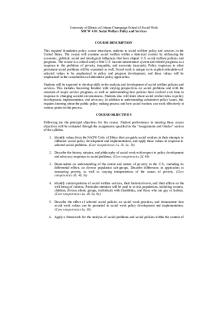SHS 410 ADHD Therapy - M. Scaub PDF

| Title | SHS 410 ADHD Therapy - M. Scaub |
|---|---|
| Course | Intervention Language Disorders |
| Institution | University of Southern Mississippi |
| Pages | 3 |
| File Size | 43.3 KB |
| File Type | |
| Total Downloads | 29 |
| Total Views | 115 |
Summary
M. Scaub...
Description
SHS 410 3-26-14 ADHD Therapy •
Bx modification is used in Tx to help structure and control Bx. It
has been used as a language training technique. •
Cognitive Behavior- clinician uses reinforcement in order to teach a
skill for Bx, and the cognitive part is learning the skill. o
Ex. Skill: teaching your client how to put a toy car together
♣
First do cognitive modeling- model how to do the skill in a
meaningful activity and talk aloud as you do it, which is called Self-Talk. The cognitive part of the activity is role-playing. Also, you are giving the child the appropriate language as you are using Self-Talk ♣
Overt External Guidance- the child now performs the task that you
showed them how to do, and the clinician verbalizes the instructions. This is called Parallel Talk. ♣
Overt Self Guidance- the child performs the task while verbalizing
aloud what they are doing. The child is now doing the Self Talk. At this point, the child has learned the language that was modeled. ♣
Faded Overt Guidance- now the child performs the task again, and he
whispers what he is doing ♣
Covert- the child is able to do the activity, and he can do the
self-instruction without having to say it aloud. He has internalized the language- he can think in the appropriate language. o
During this activity, you choose the language that you want to teach.
o
Cognitive part- you are teaching through modeling and the child
learns through imitation o
Behavior- the child begins to try out what you have modeled. It is
clinician directed. o
You are teaching the concept in a meaningful unit. You are teaching
the client to imitate what you said, in addition to internalizing and thinking in language. •
Problem Solving
o
These children do not understand, so you must teach the steps to
problem solving. ♣
Identify the problem
♣
Consider the solution
♣
Choose the solution
♣
Try the solution
♣
Evaluate
o
Can be a big issue.
•
Special Considerations
o
Inability to attend
♣
Be sure to get the child’s attention before you give instructions
♣
You may have to repeat things more than once
o
Inability to inhibit reactions
♣
Reduce the stimuli if the child has difficulty with too much going
on. For example, put the toys out in the hall. ♣
Have the child sit closer to you. This may calm the child. For a
very active child, be sure to sit between the child and the door. o
Slow processing speed
♣
Give the child more time to respond.
♣
Give small amounts of information at a time.
♣
Speak slowly
♣
Provide redundancy
♣
Sometimes it helps to say it in a different way- repeat, but differently
♣
Overtrain skills- be sure the child is good at whatever you are
asking them to do o
Problems with organizing
♣
Provide structure
♣
Provide scaffolding for the child to be successful
♣
Give the child organizational strategies and materials: calendars,
lists, and recordings. Technology can be very helpful. ♣
Help the child understand and recognize when he is becoming confused
and chaotic. •
Auditory Processing Issues
o
Auditory training and listening activities are helpful. This trains
how to follow directions. Also helps with discrimination. o
Environmental Modification
♣
Speech reading
•
Get visual cues from watching the face
♣
Amplification
•
Somewhere around 15 dB will make a difference
♣
Visual cues
•
Needed if the child has auditory issues.
•
Write things on the board
♣
Seating
•
Want the child closer to the speaker
♣
Untimed testing
•
This is a recommendation for the teacher
•
ADHD children do not do well with timed information....
Similar Free PDFs

SHS 410 ADHD Therapy - M. Scaub
- 3 Pages

ADHD Brochure
- 2 Pages

ADHD - Essay
- 4 Pages

ADHD essay
- 17 Pages

SHS Work Immersion Portfolio
- 47 Pages

2019 SOCW 410 Syllabus
- 9 Pages

PBL 410 Notes
- 125 Pages

ADHD and Cerebral Palsy
- 5 Pages

Review Essay of ADHD
- 4 Pages

ADHD in practice PHA333
- 15 Pages

ADHD Paper - Grade: A
- 6 Pages

ASUHAN KEPERAWATAN ANAK ADHD
- 49 Pages

Linee guida ADHD
- 25 Pages

ADHD - Lecture notes 3
- 7 Pages

410 Newell\'s Model paper
- 6 Pages
Popular Institutions
- Tinajero National High School - Annex
- Politeknik Caltex Riau
- Yokohama City University
- SGT University
- University of Al-Qadisiyah
- Divine Word College of Vigan
- Techniek College Rotterdam
- Universidade de Santiago
- Universiti Teknologi MARA Cawangan Johor Kampus Pasir Gudang
- Poltekkes Kemenkes Yogyakarta
- Baguio City National High School
- Colegio san marcos
- preparatoria uno
- Centro de Bachillerato Tecnológico Industrial y de Servicios No. 107
- Dalian Maritime University
- Quang Trung Secondary School
- Colegio Tecnológico en Informática
- Corporación Regional de Educación Superior
- Grupo CEDVA
- Dar Al Uloom University
- Centro de Estudios Preuniversitarios de la Universidad Nacional de Ingeniería
- 上智大学
- Aakash International School, Nuna Majara
- San Felipe Neri Catholic School
- Kang Chiao International School - New Taipei City
- Misamis Occidental National High School
- Institución Educativa Escuela Normal Juan Ladrilleros
- Kolehiyo ng Pantukan
- Batanes State College
- Instituto Continental
- Sekolah Menengah Kejuruan Kesehatan Kaltara (Tarakan)
- Colegio de La Inmaculada Concepcion - Cebu
